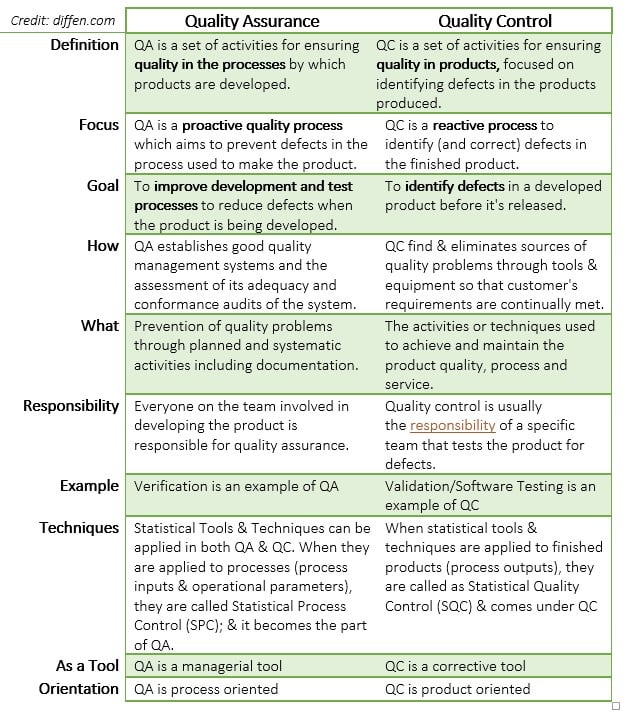
Last week we talked about a few common myths regarding Quality Control (see “5 Myths About Quality Control”), but one myth we did not cover was the one about Quality Assurance being the same thing. It’s not uncommon to hear them used interchangeably, and in a closed-loop environment of a large facility, it might not make a difference if everyone agrees to what the definitions are in their environment. But if you ever plan to use outside resources in any way, or want to make sure you are on the same page with suppliers and customers, it might be a good idea to understand the differences and apply them accordingly.
Spot the Difference!
In a very philosophical sense, “Quality Assurance“ (QA) is really about the quality of your processes, and “Quality Control” (QC) is really about the quality of your outcomes (or products). We found a great comparison chart on diffen.com, and will share it here (with some of our edits) to start off with a simple overview:

The chart itself provides an excellent overview of the basics. But how does this manifest itself in real life situations?
Examples of How Their Role Plays Out
 There is a basic example that you can apply to almost any industry with a few adjustments to the names of the processes and products. For example, if we look at something like a cell phone manufacturer, Quality Assurance would mean setting up processes necessary to prove that the devices are manufactured to the very specific specifications required. Processes may include those to test the purity or alloy composition in the raw materials and parts provided, specifying the locations, size and order of where screws are inserted or methods for polishing glass screens and when (i.e. one side right before assembly, the other after). All of these processes would fall under the name of “Quality Assurance”.
There is a basic example that you can apply to almost any industry with a few adjustments to the names of the processes and products. For example, if we look at something like a cell phone manufacturer, Quality Assurance would mean setting up processes necessary to prove that the devices are manufactured to the very specific specifications required. Processes may include those to test the purity or alloy composition in the raw materials and parts provided, specifying the locations, size and order of where screws are inserted or methods for polishing glass screens and when (i.e. one side right before assembly, the other after). All of these processes would fall under the name of “Quality Assurance”.
Quality Control, however, would be the potentially long list of physical and mechanical tests that take place during some of the above processes to not only ensure the quality assurance processes have been followed but that you also have the exact phone and quality that the design calls for. These could be comprised of both visual tests and those using testing equipment that might scan for flows like cracks, inadequate seals, electrical circuits, etc. Defects would be pulled from the line and either repaired or scrapped. We recently showed how quality control works in the apple industry too – and some of the equipment is fairly sophisticated (see the scanner used to detect brown spots inside the fruit in our Oct 23, 2018 blog)
Where do these two processes overlap? In this case, if the scrap rate in production is seen as getting too high, it would suggest a flaw in the Quality Assurance process and not just in production. High-performing QA processes should logically lead to better quality in production as well.
Think of QA as a “Prevention Strategy” and QC as your “Detection Strategy."
For Additional Reading:










